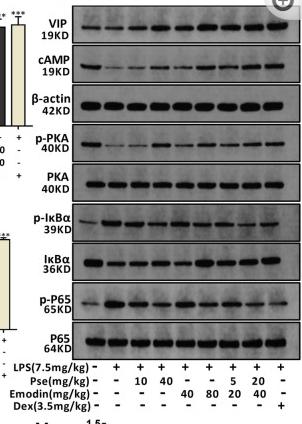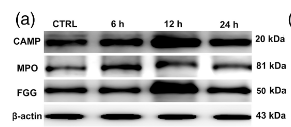Cathelicidin Antibody - #DF6523
| Product: | Cathelicidin Antibody |
| Catalog: | DF6523 |
| Description: | Rabbit polyclonal antibody to Cathelicidin |
| Application: | WB IHC |
| Cited expt.: | WB |
| Reactivity: | Human, Mouse |
| Mol.Wt.: | 19kDa; 19kD(Calculated). |
| Uniprot: | P49913 |
| RRID: | AB_2838485 |
Product Info
*The optimal dilutions should be determined by the end user. For optimal experimental results, antibody reuse is not recommended.
*Tips:
WB: For western blot detection of denatured protein samples. IHC: For immunohistochemical detection of paraffin sections (IHC-p) or frozen sections (IHC-f) of tissue samples. IF/ICC: For immunofluorescence detection of cell samples. ELISA(peptide): For ELISA detection of antigenic peptide.
Cite Format: Affinity Biosciences Cat# DF6523, RRID:AB_2838485.
Fold/Unfold
18 kDa cationic antimicrobial protein; Antibacterial peptide LL-37; Antibacterial protein FALL-39; CAMP; CAMP_HUMAN; CAP 18; CAP-18; CAP18; Cathelicidin antimicrobial peptide; Cathelin-like protein; Cathelin-related antimicrobial peptide; CATHL3; Cationic antimicrobial protein, 18-KD; CLP; Cnlp; Cramp; CRAMP, mouse, homolog of; FALL 39; FALL-39 peptide antibiotic; FALL39; hCAP 18; hCAP-18; hCAP18; HSD26; LL37; MCLP; Peptide antibiotic, PR-39, porcine, homolog of;
Immunogens
A synthesized peptide derived from human Cathelicidin, corresponding to a region within the internal amino acids.
- P49913 CAMP_HUMAN:
- Protein BLAST With
- NCBI/
- ExPASy/
- Uniprot
MKTQRDGHSLGRWSLVLLLLGLVMPLAIIAQVLSYKEAVLRAIDGINQRSSDANLYRLLDLDPRPTMDGDPDTPKPVSFTVKETVCPRTTQQSPEDCDFKKDGLVKRCMGTVTLNQARGSFDISCDKDNKRFALLGDFFRKSKEKIGKEFKRIVQRIKDFLRNLVPRTES
Research Backgrounds
Binds to bacterial lipopolysaccharides (LPS), has antibacterial activity.
The N-terminus is blocked.
Secreted.
Expressed in bone marrow and testis and neutrophils.
Belongs to the cathelicidin family.
Research Fields
· Human Diseases > Infectious diseases: Bacterial > Tuberculosis.
· Organismal Systems > Immune system > NOD-like receptor signaling pathway. (View pathway)
· Organismal Systems > Digestive system > Salivary secretion.
References
Application: WB Species: Rat Sample: lung tissues
Application: WB Species: rat Sample: intestinal
Application: WB Species: Rat Sample: Liver
Restrictive clause
Affinity Biosciences tests all products strictly. Citations are provided as a resource for additional applications that have not been validated by Affinity Biosciences. Please choose the appropriate format for each application and consult Materials and Methods sections for additional details about the use of any product in these publications.
For Research Use Only.
Not for use in diagnostic or therapeutic procedures. Not for resale. Not for distribution without written consent. Affinity Biosciences will not be held responsible for patent infringement or other violations that may occur with the use of our products. Affinity Biosciences, Affinity Biosciences Logo and all other trademarks are the property of Affinity Biosciences LTD.


